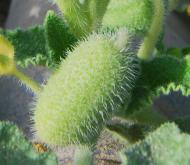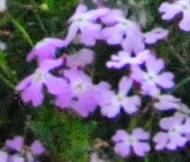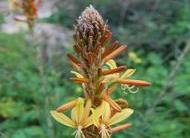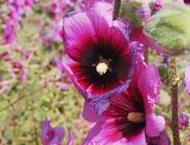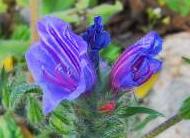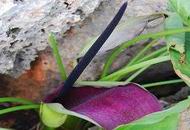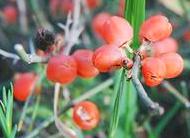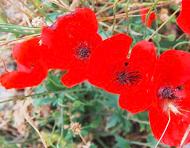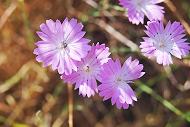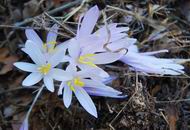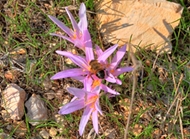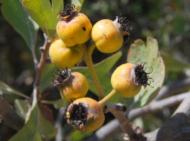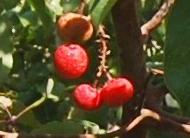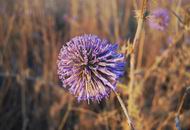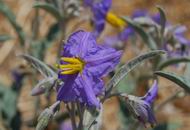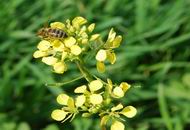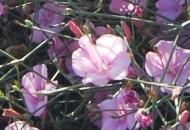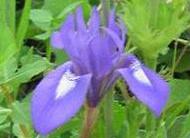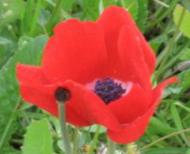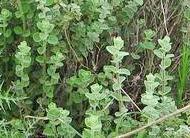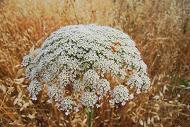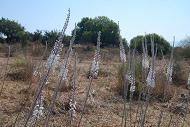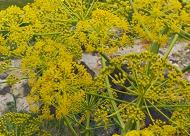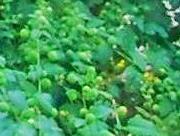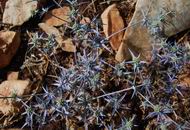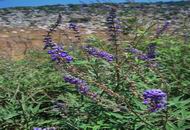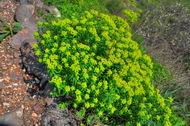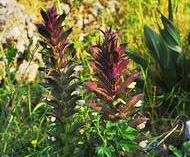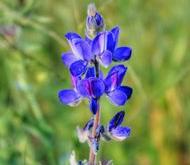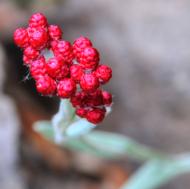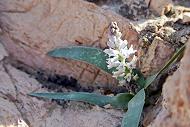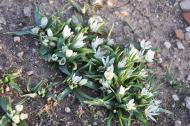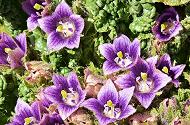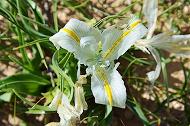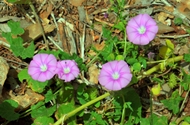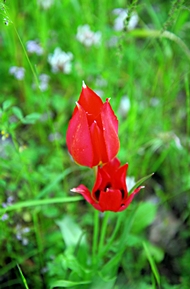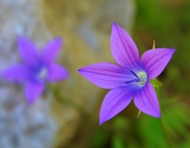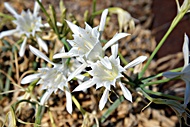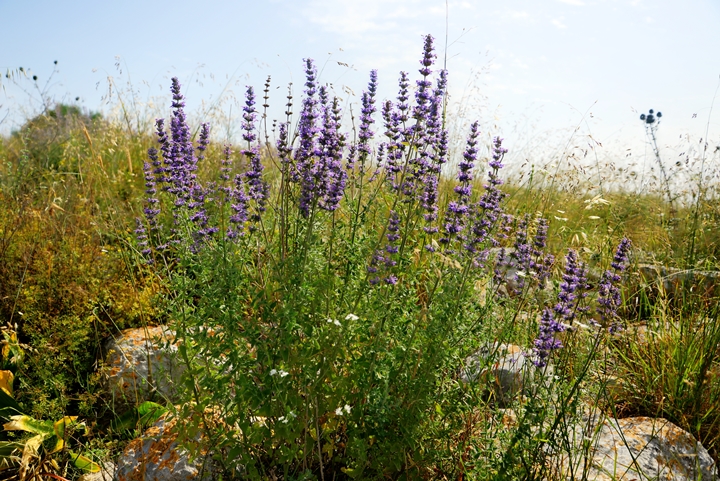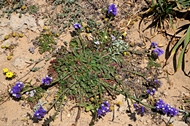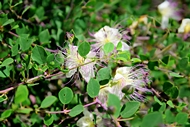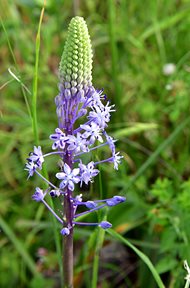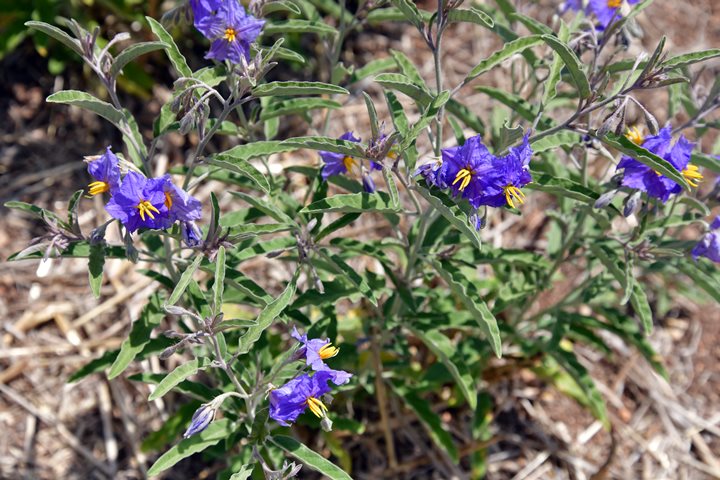A cross reference of BibleWalks sites with Nature photos – wild flowers, herbs and plants.
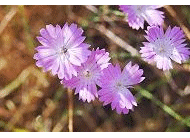
Song of Solomon 2:12: “The flowers appear on the earth; the time of the singing of birds is come”
Home > Info > Nature > Wild flowers and plants
Contents:
Overview
In the Bible
Sites with wild flowers
Biblical References
Specials
Etymology
Links
Flowers in the Bible:
Flowers are mentioned throughout the Bible, both in the Old Testament and the New Testament. Here are some examples:
- The Lily: The lily is mentioned several times in the Bible and is used as a symbol of beauty and purity. In the Song of Solomon, the lover is described as a lily among thorns.
- The Rose: The rose is also mentioned in the Song of Solomon as a symbol of beauty and love.
- The Crocus: The crocus is mentioned in the Old Testament as a symbol of beauty and restoration. In Isaiah 35:1, it says, “The desert and the parched land will be glad; the wilderness will rejoice and blossom. Like the crocus.”
- The Hyssop: The hyssop plant is mentioned several times in the Bible and was used in purification rituals. In Exodus 12:22, the Israelites are instructed to use a hyssop branch to apply the blood of the Passover lamb to their doorposts.
- The Olive Blossom: The olive tree and its blossoms are mentioned frequently in the Bible. In Psalm 52:8, it says, “But I am like an olive tree flourishing in the house of God; I trust in God’s unfailing love for ever and ever.”
- The Thistle: The thistle is mentioned in the Old Testament as a symbol of the consequences of sin. In Genesis 3:18, it says, “It will produce thorns and thistles for you, and you will eat the plants of the field.”
These are just a few examples of the many flowers and plants that are mentioned in the Bible. Flowers and plants are often used as symbols throughout the Bible to illustrate spiritual concepts and principles, such as beauty, purity, restoration, and the consequences of sin.
Sites with Wild flowers:
The following table lists the sites with wild flowers (also spelled: wildflowers), herbs and plants that are featured in BibleWalks site pages.
The name field includes up to 3 names: a common name, a scientific name in italic, and a (Hebrew name in parenthesis). To see more information – click on the site’s name. Hit the photo in order to view it in higher resolution.
Name |
Biblical & HistoricalReferences |
Feature Site(click_&_go) |
Photo(click_to_enlarge_me) |
Squirting Cucumbers Ecballium elaterium (Yerikat Hachamor) |
2 Kings 4:38-39:“And Elisha… found a wild vine, and gathered thereof wild gourds his lap full, and came and shred them into the pot of pottage…”. |
TellRegev |
|
“PrettyCarmelite”RicotiaBrassicaceae(Carmelite Na-ah) |
These delicate flowers, which grow among the rocks in most of the Galilee and here near the Carmelite monastery, are cross-shaped and resemble Carmelite crosses. |
StellaMarisTsalmon |
|
Yellow-AsphodelAsphodelinelutea(Ironi-Tzahov) |
Tall (1m)Flowers in the spring |
StellaMaris |
|
Tower of BellsAlthaeasetosa Boiss(KhatamitZifanit) |
Tall (to 3.5m!) |
GevaShemen |
|
HispidViper’s-buglossEchium Angustifolium(Achna’i) |
Flower resembles a Viper snake’s head |
Pigeonscaves |
|
Israeli LufArumPalaestinum |
Luf: from Aramaic Lufa; Arabic: Lup |
Pigeons cavesMt. Ebal
|
|
Ephedra plantFoemineaForssk(Sharvitan Matsui) |
Jerusalem Western wall: a bush of this Ephedra grew in the cracks, and during summer time it dropped water down to the prayer area. |
Migdal-Malcha |
|
Corn PoppyPapaversubpiriforme(Pereg) |
Isaiah 40 6-8:“All flesh is grass, and all its beauty is like the flower of the field. The grass withers, the flower fades when the breath of the Lord blows on it; surely the people are grass. The grass withers, the flower fades, but the word of our God will stand forever”. |
Kh. ZagagMt. Saul |
|
Oriental Viper’s GrassScorzonerapapposa(Hardufnin Hatzitzit) |
Viper: possibly use curing snake bite |
Migdal-Malcha |
|
Colchicum tauri(Sitvanit Hermon) |
Sitvanit is referred in the Mishna, the 2nd century AD books of Jewish practices, where it is said to be used to produce vinegar |
Beit Jan |
|
Jerusalem Autumn-crocusColchicum hierosolymitanum |
same as above |
Airplane hill, Jerusalem |
|
Spiny HawthornCrataegusaronia(Uzrar Kotzani) |
A Christian tradition: Jesus’ crown of thorns was twisted from twigs of the bush, and thus it is also called “Christ Thorn” |
Beit Jan |
|
Eastern StrawberryArbutusandrachne(Katlav Matsui) |
2 Samuel 18:9-17: “And Absalom rode upon a mule, and the mule went under the thick boughs of a great oak, and his head caught hold of the oak,…” |
Beit Jan |
|
Globe-thistleEchinopsadenocaulos(Kipodan) |
Matthew 13 7:“…and the thorns sprung up…”. |
Zavat |
|
Silverleaf NightshadeSolanumelaeagnifolium |
Solanum – perhaps derived from Sol (Latin for sun) |
Zavat |
|
DaffodilsNarcissus(Narkis) |
Possibly – Lily of the valleys:Song of Solomon 2 1: “I am the rose of Sharon, and the lily of the valleys”. |
ZavatKabra |
|
Wild white mustardSynapis alba(Hardal Lavan) |
Used to make mustard from seeds |
Zavat |
|
Splendid BindweedConvolvulusdorycnium(Khavalval-Hasi’akh) |
Convolvulus – from Latin – to twine around |
El Khader |
|
Cyclamenpersicum(Rakkefet) |
ShartaMigdal Haemek |
|
|
Barbary NutIrissisyrinchium(Tsaharon) |
Sharta |
|
|
Anemone(Calanit) |
Possible Biblical identification:Isaiah 17 10: “Because thou hast forgotten the God of thy salvation … therefore shalt thou plant pleasant plants,…”. |
Sharta |
|
Hyssop HerbOriganumsyriaca(Ezov Matsui,Za’atar) |
Exodus 12:22:“And ye shall take a bunch of hyssop, and dip it in the blood that is in the basin, and strike the lintel and the two side posts with the blood that is in the basin”. |
Sharta |
|
ToothpickAmmi majus(Ammita Gdola) |
Kh. Bata |
|
|
SquillUrgineamaritima(Hazav) |
(Legend) Joshua used the squill bulbs to mark the borders between the tribes. |
UshaZipporiMazorRakkathAkhbara |
|
CommonGiant FennelFerulacommunis(Kelech Matsui) |
Job 30 2: “Yea, whereto might the strength of their hands profit me, in whom old age was perished?” |
Tell BeitShean |
|
Roman NettleUrticapilulifera(Sirpad Hakadurim) |
Job 30, 7: “Among the bushes they brayed; under the nettles they were gathered together”. |
Tabor –Greek Orth. |
|
Eryngiumcreticum(Charchevina -Makchila) |
Listed in the Mishna: one of the plants that are allowed as Passover bitter herbs (Passachim 2: 6). |
Beit Uriyah |
|
Lilac Chaste Tree –Monk’s PepperVitex agnus-castus(Siach Avraham Matsui) |
Genesis 22, 13: “And Abraham lifted up his eyes, and looked, and behold behind him a ram caught in a thicket by his horns: and Abraham went and took the ram, and offered him up for a burnt offering in the stead of his son”. |
Hilazon |
|
Jerusalem SpurgeEuphorbia Hierosolymitana(“Khalavluv Meguvshash”) |
This shrub covers most of Gamla; flowers in winter, painting the site in yellow-green. |
GamlaTemple cave |
|
Syrian Bear’s-breechAcanthusSyriacus(“Koziz Suri”) |
Omrit |
|
|
BlueLupineLupinuspilosus(Turmus HeHarim) |
Omrit |
|
|
RedEverlastingHelichrysum sanguineum(“Dam Hamacabim”) |
According to the legend, the flower commemorates a place where the blood of the 2nd C BC Israelite freedom-fighter has been spilled. |
Dan |
|
Desertorum Bellevalia(Zamzumit Hamidbar) |
Desert flower found in Jordan, Judea, Negev, Sinai. Blooms in winter. |
Horkania |
|
BethlehemStarOrnithogalum lanceolatum |
Star-like flower links to story of Bethlehem star, that revealed the birth of Jesus to the wise men. |
Kabra |
|
Mountain star of BethlehemOrnithogalum montanum |
Another Star-like flower links to story of Bethlehem star, that revealed the birth of Jesus to the wise men. |
Mt. Ebal |
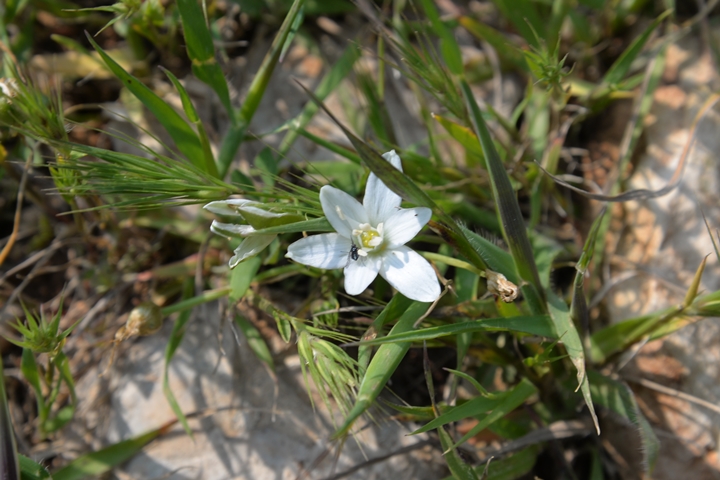 |
Mandrake flowersMandragora autumnalis(Hebrew: Duda’im) |
Fruits of this plant were used for treating fertility problems (Genesis 30:14): “And Reuben … found mandrakes in the field, brought them unto his mother Leah. Then Rachel said to Leah, Give me, I pray thee, of thy son’s mandrakes”. |
Yattir |
|
Israeli IrisIris Palaestina |
A small flower with white flowers and yellow strips. |
Yattir |
|
Syrian BindweedConvolvulus CoelesyriacusBois(Havalval Suri) |
Annual vine, flowers in March to May |
H. Danaila |
|
TulipTulipa agenensisTulipa is based on the Turkish name Turban – meaning hat.(Tsivoni He-Harim) |
Flowers February thru April, just before spring.In 17th century Ottoman Sultan gave bulbs as present to the Austrian ambassador. It was adapted in Netherlands and became their national flower. |
HorvatHanut |
|
Syrian Cornflower-thistle, KnapweedCentaurea cyanoides(Hebrew: Dardar Kakhol) |
Flowers March thru May. |
HorvatHanut |
|
Iris GilboaIris Haynei(Hebrew: Iris Ha-Gilboa) |
Flowers March thru April, on high Gilboa mountain; Best place to see these flowers is a forest near Malkishua. |
Gilboa |
|
CharlockSinapis arvensis(Hebrew: Hardal Hasadeh) |
Flowers December thru May, covers large areas |
Many sites |
|
Campanula Sidoniensis(Hebrew:Pa’amonit Zidonit) |
Flowers April and May. |
Horvat Zunam |
|
Sea daffodilPancratium Maritimum |
Song of Solomon, 2 : 1-2: “I am the rose of Sharon, and the lily of the valleys. As the lily among thorns, so is my love among the daughters”. |
Masref |
|
Pink Butterfly OrchidOrchis papilionacea L. |
Flowers February-April. |
Temple cave |
|
Syrian CantipNepeta curviflora (Hebrew: Nepit Kefufa) |
Flowers April-June |
el Hamam |
|
Cut-Leaf Sea-LavenderLimonium sinuatu (Hebrew: Ad-Ad Kachol) |
Flowers March-June along the beaches |
Tel Gador |
|
| Common Caper
Capparis Sicula (Hebrew: Zalaph Sicily)
|
Its name appears in Nehemiah 3:30 (“Hanun the sixth son of Zalaph”).In the Talmud (Sabbath 30 2), Rabban Gamliel uses the Caper as an example for renewal. |
Karm er-Ras |
|
| Crimson Iris
Iris atropurpurea (Hebrew: Irus Argaman)
|
Crimson colored Iris flowers found on the coast line.A concentration is found in Natanyah Irus Argaman nature reserve, flowering February thru March. |
Netanyah nature reserve |
|
| Common Asphodel
Asphodelus ramosus (Hebrew: Irit Gdola)
|
A large plate with tall flowers. Flowers January thru April.Possible identification (Mishnah Kelim 3:6): Yablit – used to prepare cement for repairing wine jugs.
|
Ruchama (Kh. Jemmameh) |
|
| Hyacinth Squill
Scilla hyacinthoides (Hebrew: Ben Hazav Yakintoni)
|
flowers in March/April with purple flowers on 1–1.5 m high flowering stalks. |
Zakur |
|
| Hoary Nightshade, Palestine Nightshade;
Solanum incanum (Hebrew: Solanum Hakhedek) |
A thorny shrub, flowers Jan to Aug with purple flowers.It is negatively mentioned in the Bible, compared to a lazy man:Proverbs 15:19: “The way of the slothful man is as an hedge of thorns: but the way of the righteous is made plain.” In Hebrew the phrase “hedge of horns” is spelled “דֶּרֶךְ עָצֵל כִּמְשֻׂכַת חָדֶק”. |
Tarbenet |
|
Specials:
Some outstanding views of wildflowers can be seen in Israel. Here are some samples.
- Anemone (Calanit) in Maoz Haim, Beth Shean Valley [Feb 2012]:
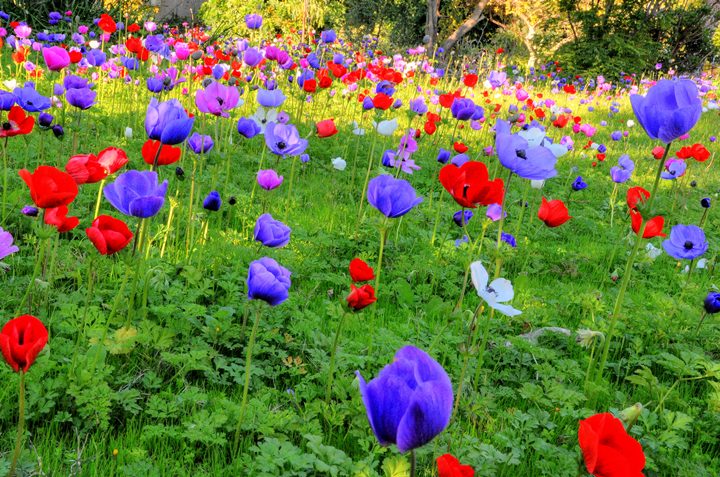
- The “Darom Adom” (“Red South”) festival is held in the Negev area during the winter season, when hundred of thousands of red Anemone (Calanit) flowers cover the fields. [Ruchama, February 2022].
Photo with new D850 camera
Biblical references:
These are dozens of references to flowers, herbs and plants in the Bible. Here are some samples –
Song of Solomon 2:12: “The flowers appear on the earth; the time of the singing of birds is come”
Psalms 103:15: “As for man, his days are as grass: as a flower of the field, so he flourisheth.”
Proverbs 15:17: “Better is a dinner of herbs where love is, than a stalled ox and hatred therewith”.
Genesis 1:11: “And God said, Let the earth bring forth grass, the herb yielding seed, and the fruit tree yielding fruit after his kind, whose seed is in itself, upon the earth: and it was so”.
Job 14 9:”Yet through the scent of water it will bud, and bring forth boughs like a plant.”
Etymology (behind the name):
- Perach, Perah – Hebrew: flower
- Bar – Hebrew: wild
Links:
- Wild flowers of Israel – guide to Israeli wild flowers.
- Tiuli – Flowers of Israel
- Plants in the Bible
BibleWalks.com – “The flowers appear on the earth; the time of the singing of birds is come”
Airport mosaics <<<—Previous info—<<< All Info >>>—Next Info—>>> Trees
This page was last updated on June 1, 2024 (add Solanum)
Sponsored links:
